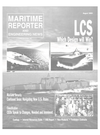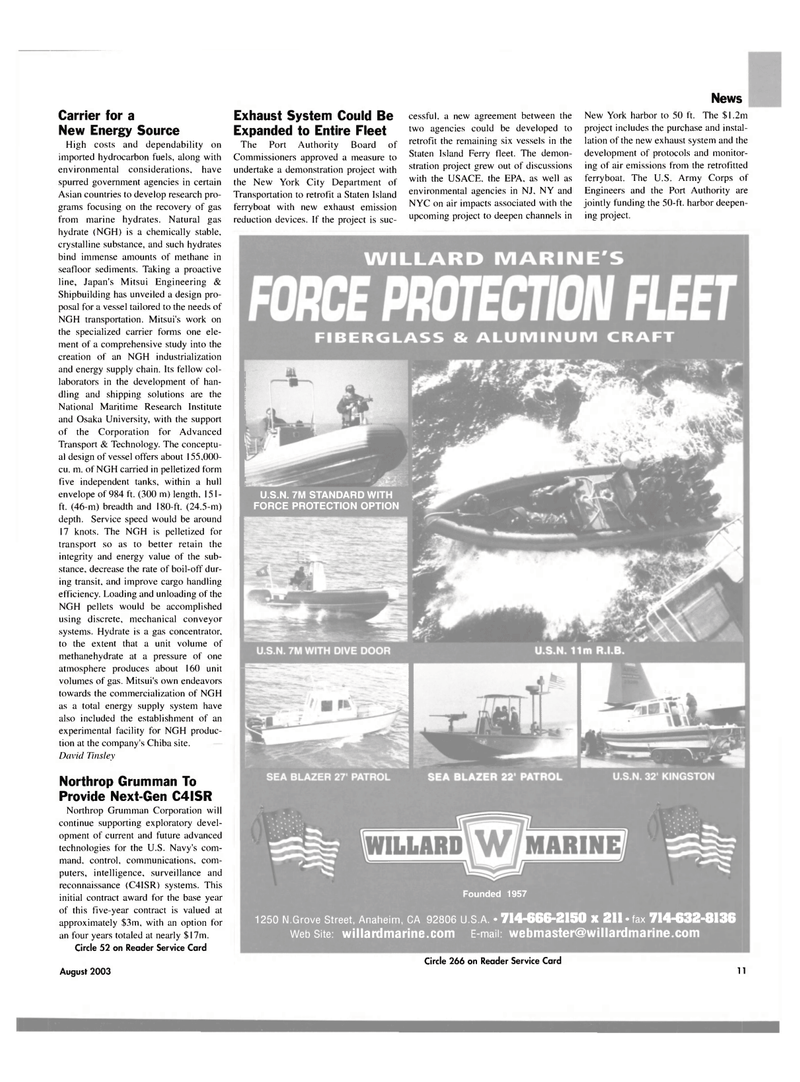
Page 11: of Maritime Reporter Magazine (August 2003)
Read this page in Pdf, Flash or Html5 edition of August 2003 Maritime Reporter Magazine
Carrier for a
New Energy Source
High costs and dependability on imported hydrocarbon fuels, along with environmental considerations, have spurred government agencies in certain
Asian countries to develop research pro- grams focusing on the recovery of gas from marine hydrates. Natural gas hydrate (NGH) is a chemically stable, crystalline substance, and such hydrates bind immense amounts of methane in seafloor sediments. Taking a proactive line, Japan's Mitsui Engineering &
Shipbuilding has unveiled a design pro- posal for a vessel tailored to the needs of
NGH transportation. Mitsui's work on the specialized carrier forms one ele- ment of a comprehensive study into the creation of an NGH industrialization and energy supply chain. Its fellow col- laborators in the development of han- dling and shipping solutions are the
National Maritime Research Institute and Osaka University, with the support of the Corporation for Advanced
Transport & Technology. The conceptu- al design of vessel offers about 155,000- cu. m. of NGH carried in pelletized form five independent tanks, within a hull envelope of 984 ft. (300 m) length, 151- ft. (46-m) breadth and 180-ft. (24.5-m) depth. Service speed would be around 17 knots. The NGH is pelletized for transport so as to better retain the integrity and energy value of the sub- stance, decrease the rate of boil-off dur- ing transit, and improve cargo handling efficiency. Loading and unloading of the
NGH pellets would be accomplished using discrete, mechanical conveyor systems. Hydrate is a gas concentrator, to the extent that a unit volume of methanehydrate at a pressure of one atmosphere produces about 160 unit volumes of gas. Mitsui's own endeavors towards the commercialization of NGH as a total energy supply system have also included the establishment of an experimental facility for NGH produc- tion at the company's Chiba site.
David Tinsley
Exhaust System Could Be
Expanded to Entire Fleet
The Port Authority Board of
Commissioners approved a measure to undertake a demonstration project with the New York City Department of
Transportation to retrofit a Staten Island ferryboat with new exhaust emission reduction devices. If the project is suc- cessful, a new agreement between the two agencies could be developed to retrofit the remaining six vessels in the
Staten Island Ferry fleet. The demon- stration project grew out of discussions with the USACE, the EPA, as well as environmental agencies in NJ, NY and
NYC on air impacts associated with the upcoming project to deepen channels in
News
New York harbor to 50 ft. The $1.2m project includes the purchase and instal- lation of the new exhaust system and the development of protocols and monitor- ing of air emissions from the retrofitted ferryboat. The U.S. Army Corps of
Engineers and the Port Authority are jointly funding the 50-ft. harbor deepen- ing project.
Northrop Grumman To
Provide Next-Gen C4ISR
Northrop Grumman Corporation will continue supporting exploratory devel- opment of current and future advanced technologies for the U.S. Navy's com- mand, control, communications, com- puters, intelligence, surveillance and reconnaissance (C4ISR) systems. This initial contract award for the base year of this five-year contract is valued at approximately $3m, with an option for an four years totaled at nearly $17m.
Circle 52 on Reader Service Card
August 2003
Circle 266 on Reader Service Card 11
U.S.N. 7M STANDARD WITH
FORCE PROTECTION OPTION
Founded 1957 1250 N.Grove Street, Anaheim, CA 92806 U.S.A. • 714-666-2150 X 211 • fax 714-632-8136
WebSite: willardmarine.com E-mail: [email protected]

 10
10

 12
12
